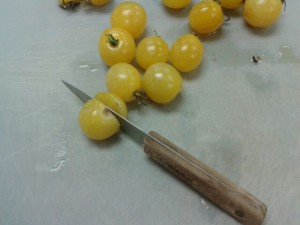Last year I ate the yummiest cherry tomatoes EVER. A coworker left some on my desk and I enjoyed them thoroughly. By the time I asked her for more so I could save the seeds, it was too late! Her family had eaten all the tomatoes. And who could blame them? They were absolutely delectable.
The tomato I’m gushing about is called Snowberry. When it comes to cherry tomatoes, the sweeter the better, in my humble opinion. I used to adore Sungold, and for years it was my “go to” cherry tomato. However, it was easily dethroned by Snowberry. This tomato is super sweet, has thin skin and is a really pretty shade of pearly yellow. This year I was determined to save the seeds. Luckily my co-worker was grew them again and agreed to share.
Snowberry is an heirloom tomato, which means the seeds have been saved and handed down for many generations between families and friends. Once planted, an heirloom tomato seed will reproduce itself. The seeds inside the tomatoes planted can be saved and grown again the following year.
When saving tomato seeds, avoid the seeds of hybrid tomatoes. These tomato seeds cannot reproduce themselves. If you plant them, you’ll get something strange that may or may not taste edible. This is because a hybrid is the result of a cross between two different tomatoes chosen by plant breeders for specific characteristics.
The very first hybrid tomato was created by Burpee Seed Company. The tomato was a cross between a pink beefsteak tomato called Teddy and another tomato seed that remains a corporate secret. The first hybrid tomato was called Big Boy and was popular with home gardeners when it first debuted in 1949. Years later, Burpee improved upon the tomato and came up with Better Boy, which is a very popular home garden tomato today.
Aside for breeding for desirable characteristics, plants are also bred to resist pests and diseases. For example Better Boy VFN is resistant to the diseases Verticillium wilt, Fusarium wilt and Nematode pests. Gardeners with wilt diseases and nematodes present in their soil cannot grow tomatoes at all, so lucky for them these hybrids exist.
Okay, back to seed saving! Cut up your tomatoes and then squish out the seeds into a container. Cover seeds with about 2-3 inches of lukewarm water. This water will help aid the development of a fungus that will grow around the seeds and help remove the gooey, mucilaginous material that protects them. This material is so protective that a tomato seed can travel through your stomach (imagine all that acid) and pass through both your large and small intestines and remain intact!
Leave your tomato seeds in the water for 3-5 days, adding more water if it gets low. During this time the aforementioned stinky fungus will begin to grow. If you plan on having house guests (or you have housemates) you’ll want to let them know ahead of time what you plan to do. This watery, fungi filled tomato seed mixture needs to stay in a place that isn’t too hot or too cold, at about 75 F.
After a few days its time to rise the seeds. Add more water to the mixture and swirl it around. The fungi will float to the top and the seeds will sink to the bottom. Gently pour out the fungi while keeping the seeds. As you get towards the bottom of the container you can use a sieve to save the seeds.
Shake off the remaining water and then pour the seeds onto a double sheet of newspaper. Keep seeds in a warm, dry place until the water has evaporated. Then gently pull the seeds off the newspaper with your fingers. If the seeds stick together in clumps, lightly rub them between your fingers and they will come apart.
For your last step, put seeds into an envelope. Make sure to label the envelope with the name of the seeds and the date. Then keep for next year and plant about 4-6 weeks before you plan to plant outdoors. Tomato seeds can last for several years. If you come across some you’ve saved you can always do a germination test to find out if they will sprout. Put the tomato seeds in a moistened napkin inside a plastic baggie and wait for a week. If half the seeds sprout, you’ve got a 50% germination rate, and so on.
I hope to hear from you about your seed-saving adventures. Please drop me a line!
Comments
comments
